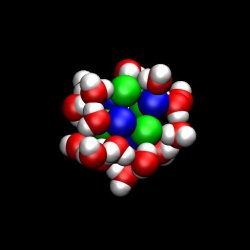Crystals and Catalysts and Clusters, Oh My!
Scientists reveal inner workings of tiny particles vital to industry, environment
(June 2009)

To make designing new materials a reality, scientists developed methods to determine how fast clusters of molecules, such as this salt and water cluster, form and their corresponding stability. Enlarge Image.
Results: Solving the nation's energy crisis requires designer materials, such as crystals and catalysts, with very specific properties. Creating these properties requires scientists to design new materials molecule by molecule. To make designing these materials a reality, scientists at Pacific Northwest National Laboratory, Louisiana State University, and the University of Minnesota developed methods to determine how fast clusters of molecules form and their corresponding stability.
"You don't get these types of novel materials from smashing matter into tiny bits," said Dr. Shawn Kathmann, a theoretical physicist at PNNL. "You get these nanomaterials by building them from the ground up."
An article on the team's new theoretical and computational methods is highlighted as a feature article on the cover of the Journal of Physical Chemistry, June 18, 2009.
Why It Matters: Understanding the molecular-level reactions that produce aqueous nanoparticles ultimately aid in designing better crystals for manufacturers and new catalysts for producing alternative fuels. Nucleation is at the heart of building—atom by atom—materials with desirable optical and electrical properties.
Methods: Previously, nanoparticle formation was described using bulk properties of matter. For example, when describing how platinum catalytic nanoparticles form, scientists simply used an element's bulk density and surface tension. However, the PNNL-led team showed that the clusters' formation process must be described at the molecular level, without appeal to bulk properties.
To understand the reactions that create nanoclusters, the team first designed new theoretical and computational approaches to studying the nanoparticle formation. "Nucleation is very difficult to study experimentally," said Dr. Greg Schenter, a theoretical physicist at PNNL. "When the particles form it is spontaneous."
With the new approach, the team determined the rate constants or how fast the clusters dissociated or fell apart. Next, they determined the thermodynamic stability of the clusters. Dr. Bin Chen of Louisiana State University and Dr. J Ilja Siepmann of the University of Minnesota provided a streamlined approach to calculate cluster thermodynamics.
Getting the kinetic and thermodynamic properties of nanoparticle formation as well as the underlying theories to provide consistent results was challenging. However, the team persevered and can now report closely aligned results that complement one another.
What's Next: The team continues to delve into the science necessary to design nanoparticles.
Acknowledgments: The U.S. Department of Energy, Office of Science, Office of Basic Energy Sciences funded this research.
Calculations were performed in part using the computational resources at DOE's EMSL, a national scientific user facility at PNNL.
The research was done by Dr. Shawn Kathmann, Dr. Greg Schenter, and Dr. Bruce Garrett of PNNL; Dr. Bin Chen of Louisiana State University; and Dr. J Ilja Siepmann of the University of Minnesota.
Reference: Kathmann SM, GK Schenter, BC Garrett, B Chen, and JI Siepmann. 2009. "Thermodynamics and Kinetics of Nanoclusters Controlling Gas-to-Particle Nucleation," Journal of Physical Chemistry C 113(24):10354-10370. DOI: 10.1021/jp8092226.

